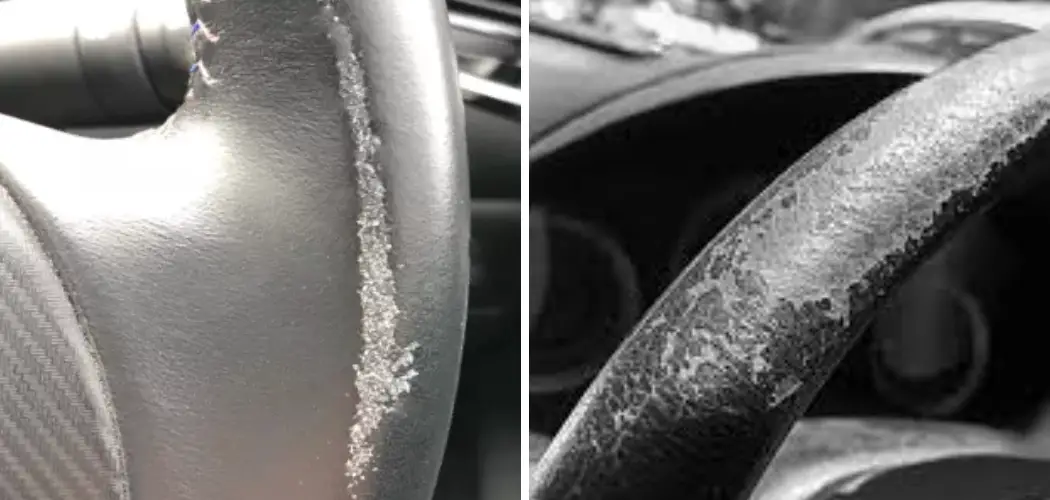Do you have a steering wheel that is peeling? Don’t worry. You are not alone. Many people have this problem, but there is a solution. This post will tell you how to fix a peeling steering wheel. We will also provide tips on how to prevent it from happening again. Keep reading to learn more!
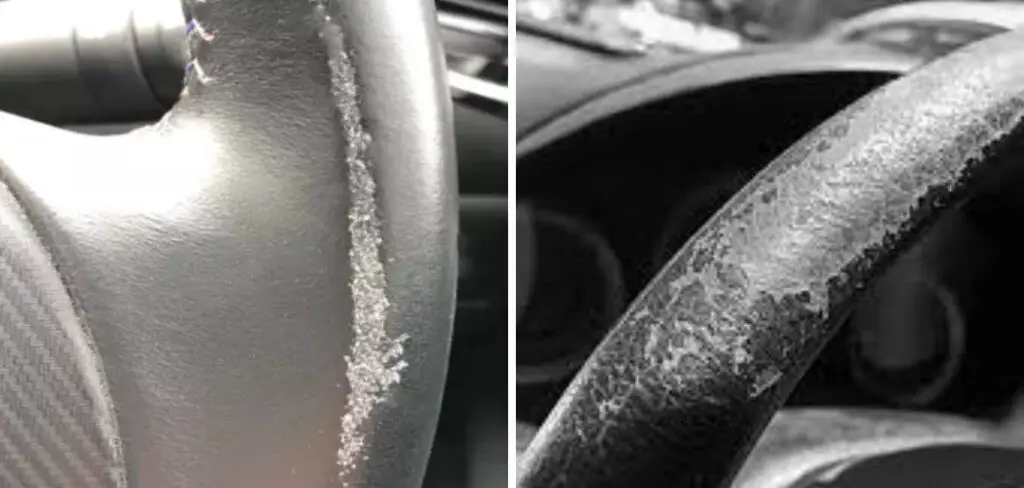
Few things are more frustrating than a peeling steering wheel. Not only does it look tacky, but it can also be dangerous if it gets too bad. Here’s how to fix it and restore your steering wheel to its former glory.
As the weather becomes warmer and the days grow longer, it’s time to start thinking about road trips! Don’t worry if your car needs repairs before hitting the open road. This blog post will show you how to fix peeling steering wheel. Follow these simple steps, and your car will be ready for your next adventure!
What Causes Peeling Steering Wheel to Peel Off?
There are a few potential causes for your steering wheel to peel. One possible reason is age, as the material on older steering wheels can start to wear down and peel over time.
Another potential cause could be UV exposure or extreme temperatures, which can also damage the material on your steering wheel. And finally, some vehicles may have faulty materials that are prone to peeling.
Additionally, improper cleaning and maintenance can contribute to peeling steering wheels. So, ensure you regularly clean and care for your car’s interior to prevent this issue from happening.
Overall, it’s important to identify the root cause of your peeling steering wheel before attempting to fix it. This will help you determine the best course of action and prevent future issues.
What Will You Need?
Before you start repairing your steering wheel, gather the necessary tools and materials.
- Steering wheel repair kit
- Rubbing alcohol
- Soft cloths or microfiber towels
- Protective gloves
With these items on hand, you’ll be ready to start fixing your steering wheel.
10 Effective Steps on How to Fix Peeling Steering Wheel:
Step 1. Use Rubbing Alcohol
Start by cleaning the steering wheel with rubbing alcohol and a microfiber towel. This will remove any dirt or debris that may be stuck on the surface, ensuring a smooth repair process. Be careful not to press down too hard, as this could damage the steering wheel even more. Because rubbing alcohol is flammable, ensure the steering wheel is not near open flames or heat sources.
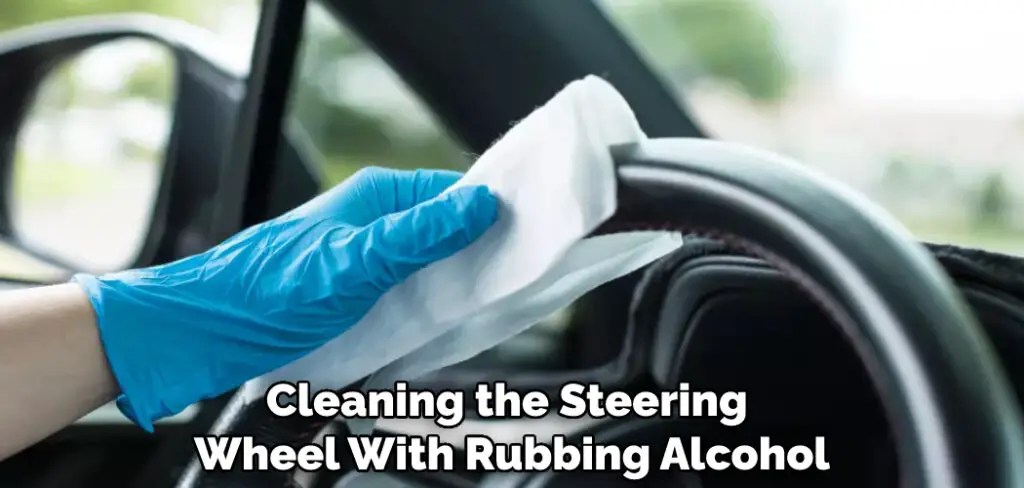
Step 2. Follow the Instructions in Your Repair Kit
Next, carefully follow the instructions that come with your steering wheel repair kit. This will vary depending on the brand and type of kit you’re using, so be sure to read through all the instructions before starting. Don’t be afraid to ask for help if you’re unsure about any steps.
Step 3. Prepare and Apply the Repair Material
Prepare the repair material according to the kit’s instructions, then apply it evenly on the steering wheel. Be sure to cover any peeling or damaged areas, but avoid applying it too thickly as this could cause issues with grip. You can use the included tools or a craft stick to spread the material smoothly.
Step 4. Allow Adequate Drying Time
Allow enough time for the repair material to dry completely, following the recommended drying times in your kit’s instructions. This step is important in ensuring a successful repair and preventing future damage to your steering wheel. Make sure the steering wheel is not in use during the drying process.
Step 5. Smooth Out Any Bumps or Imperfections
Once dried, use a microfiber towel to smooth out any bumps or imperfections in the repair material. If needed, repeat steps 2-5 to fully restore your steering wheel and fix any remaining peeling or damage. Be careful not to apply too much pressure while smoothing out the material.
Step 6. Clean and Polish Your Steering Wheel
Once fully repaired, clean and polish your steering wheel using a mild cleanser and microfiber towel. This will help remove any excess repair material and restore a glossy finish on the steering wheel. You can use a protective spray or sealant for added protection against future peeling and damage.
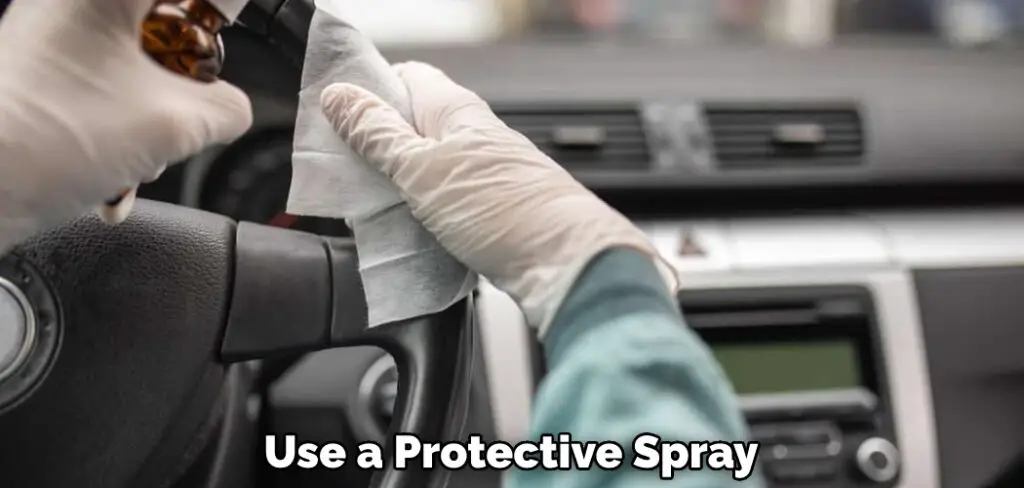
Step 7. Let Dry Completely
Allow ample drying time before using your car again to ensure the cleaning products don’t affect the grip on the steering wheel. Avoid using any harsh or abrasive cleaners, as these can damage the steering wheel’s material.
Step 8. Test Out Your Repaired Steering Wheel
Once fully dry, test out your steering wheel to ensure a smooth and comfortable grip. You can also check for any remaining peeling or damage that may need to be addressed. It is important to regularly inspect your steering wheel for any issues and fix them as soon as they are identified.
Step 9. Maintain Your Steering Wheel
Regularly clean and maintain your steering wheel using mild cleansers and microfiber towels to prevent future peeling or damage. Additionally, avoid exposing the steering wheel to extreme temperatures or UV light as much as possible. Because the steering wheel is used frequently, it is important to inspect it regularly and address any issues promptly.
Step 10. Consider Professional Assistance
If you’re unsure about the repair process or have concerns about potential damage, consider seeking professional assistance with repairing your steering wheel. This can ensure a successful repair and prevent any further issues down the road. So, don’t hesitate to ask for help if needed.
By following these steps, you can effectively fix a peeling steering wheel and restore it to its original condition. Remember to clean and maintain the steering wheel regularly to prevent future damage. And if needed, don’t hesitate to seek professional assistance for a successful repair.
5 Additional Tips and Tricks:
1. Remove Any Excess Grease or Dirt: Use a degreaser or all-purpose cleaner to remove any excess grease or dirt on the steering wheel before beginning the repair process.
2. Use Sandpaper to Rough Up the Area: Use fine-grit sandpaper to rough up the area where the steering wheel is peeling. This will help the adhesive adhere better to the surface.
3. Apply Leather or Vinyl Adhesive: Use leather or vinyl adhesive to apply to the rough surface, making sure to cover the entire area where the steering wheel is peeling.
4. Use Weights to Hold It in Place: Place weights on top of the adhesive to hold it in place and let it dry for at least 24 hours.
5. Apply Leather or Vinyl Conditioner: Once the adhesive has dried, apply leather or vinyl conditioner to the steering wheel to restore its shine and luster.
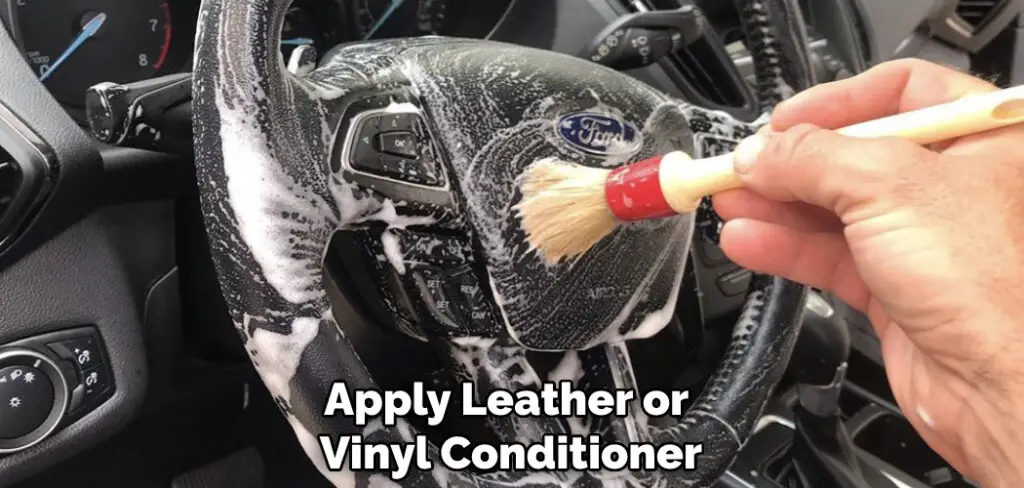
These tips and tricks will help you successfully fix a peeling steering wheel. Remember to take caution when using any type of adhesive or cleaner on your steering wheel.
5 Precautions You Can Take While Fixing Your Peeling Steering Wheel
1. First, make sure your car is in a safe location and ensure the engine is off before starting any repairs.
2. Next, gather the necessary materials, including adhesive or leather repair kits, sandpaper, and cleaning supplies.
3. Then clean the steering wheel thoroughly before beginning any repairs.
4. Don’t rush the repairs; follow the instructions for your adhesive or leather repair kit closely.
5. Finally, allow enough time for the steering wheel to dry fully before driving your car.
Following these precautions can ensure a successful and safe fix for your peeling steering wheel. Happy repairing!
Does Heat Cause Leather to Peel?
While heat can cause the leather to dry out and crack, it typically does not directly cause peeling. However, excessive heat exposure and other factors, such as poor maintenance or low-quality leather, can contribute to peeling.
Maintaining your leather properly and using high-quality materials can help prevent peeling caused by heat. Additionally, keeping your car and steering wheel out of direct sunlight can also help protect against peeling.
It’s important to note that while heat may not directly cause peeling, it can still accelerate the deterioration of the leather on your steering wheel. Proper maintenance and care are key in preventing peeling and other damage caused by heat.

Frequently Asked Questions
What Causes Steering Wheel to Peel?
There are a few reasons why a steering wheel may peel. The most common is that the plastic becomes brittle over time, and the wheel can start to break off at the seams. Other causes can include water getting inside the wheel, a defect in the manufacturing process, or using an incorrect adhesive. In any case, if you notice your steering wheel starting to peel, it’s best to take it to a mechanic for inspection.
Can You Recoat a Steering Wheel?
Yes, it is possible to recoat a steering wheel. This process can be done by either painting or re-coating the wheel with a protective agent. Painting the wheel will usually provide a longer-lasting finish than re-coating the wheel, but both methods have their own advantages and disadvantages. Painting the wheel can be done quickly and easily by a homeowner, while re-coating the wheel can be done by a professional contractor.
Paintings that are applied to metal surfaces such as steering wheels should be dry to the touch within 24 hours after application. If the paint is not dry, it may peel or chip off during use or during weather conditions such as rain or snow. When painting a steering wheel, it is important to use a coat of paint that is specifically designed for metal surfaces. Other types of paints may not adhere well to metal and may lead to poor finishes or peeling paint.
What Kind of Paint Can I Use on My Steering Wheel?
There are a variety of paints that can be used on a steering wheel, but it is important to use a paint that is specifically designed for use on steering wheels. Some common paints that are suitable for steering wheel use include:
1. Automotive paint: Automotive paint is designed to protect and extend the life of steering wheels and other car components, and it is typically a low- toxicity paint that is safe to use on surfaces such as the steering wheel.
2. Polyurethane paint: Polyurethane paint is a type of protective coatings that are often used on cars and other surfaces to inhibit water, oil, and dirt from sticking to them. It is also compatible with most types of paint, so you can use any type of paint you want on the polyurethane coating.
3. Acrylic paint: Acrylic paint is a type of water-based paint that is easy to apply and has a smooth finish. It is ideal for applications such as the steering wheel because it is lightweight and won’t require a lot of coats to achieve the desired result.
Can Cracked Peeling Leather Be Repaired?
Cracked peeling leather can be repaired, but the repair process is not always easy or straightforward. Depending on the severity of the damage, the repair may involve a number of steps and may require specialized materials or equipment. In general, the Repair process typically involves the following steps:
1. Clean and dry the area where the damage occurred
2. Apply a topical treatment to protect the area from further moisture damage
3. Apply a layer of adhesive to the area
4. Place a layer of plastic or leather patch over the adhesive
5. Reinforce the patch with a second layer of adhesive and plastic or leather
6. Allow the patch to cure or harden
7. Remove the plastic or leather patch
8. Clean and polish the area
Conclusion
You don’t have to spend much money or time fixing a peeling steering wheel. By following the tips in this article, you can quickly and easily repair your steering wheel to look new again.
In conclusion, if your steering wheel is peeling, there are a few things you can do to fix it. You can try sanding down the spot and repainting it, or you can buy a new steering wheel cover. If neither of these options works, then you might need to replace your entire steering wheel.
Thank you for reading! I hope this article was able to help shed some light on the causes of a peeling steering wheel and how to fix peeling steering wheel. If your steering wheel is starting to peel, don’t wait until it’s completely ruined to take action. Use these tips as soon as possible to ensure that your car stays in good condition for years to come.

